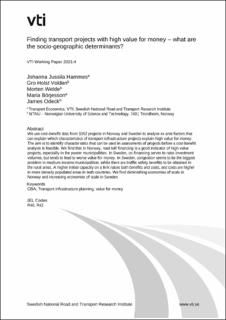| dc.description.abstract | We use cost-benefit data from 1052 projects in Norway and Sweden to analyse ex ante factors that can explain which characteristics of transport infrastructure projects explain high value for money. The aim is to identify characteristics that can be used in assessments of projects before a cost-benefit analysis is feasible. We find that in Norway, road toll financing is a good indicator of high value projects, especially in the poorer municipalities. In Sweden, co-financing serves to raise investment volumes, but tends to lead to worse value for money. In Sweden, congestion seems to be the biggest problem in medium-income municipalities, while there are traffic safety benefits to be obtained in the rural areas. A higher initial capacity on a link raises both benefits and costs, and costs are higher in more densely populated areas in both countries. We find diminishing economies of scale in Norway and increasing economies of scale in Sweden. | en_US |
